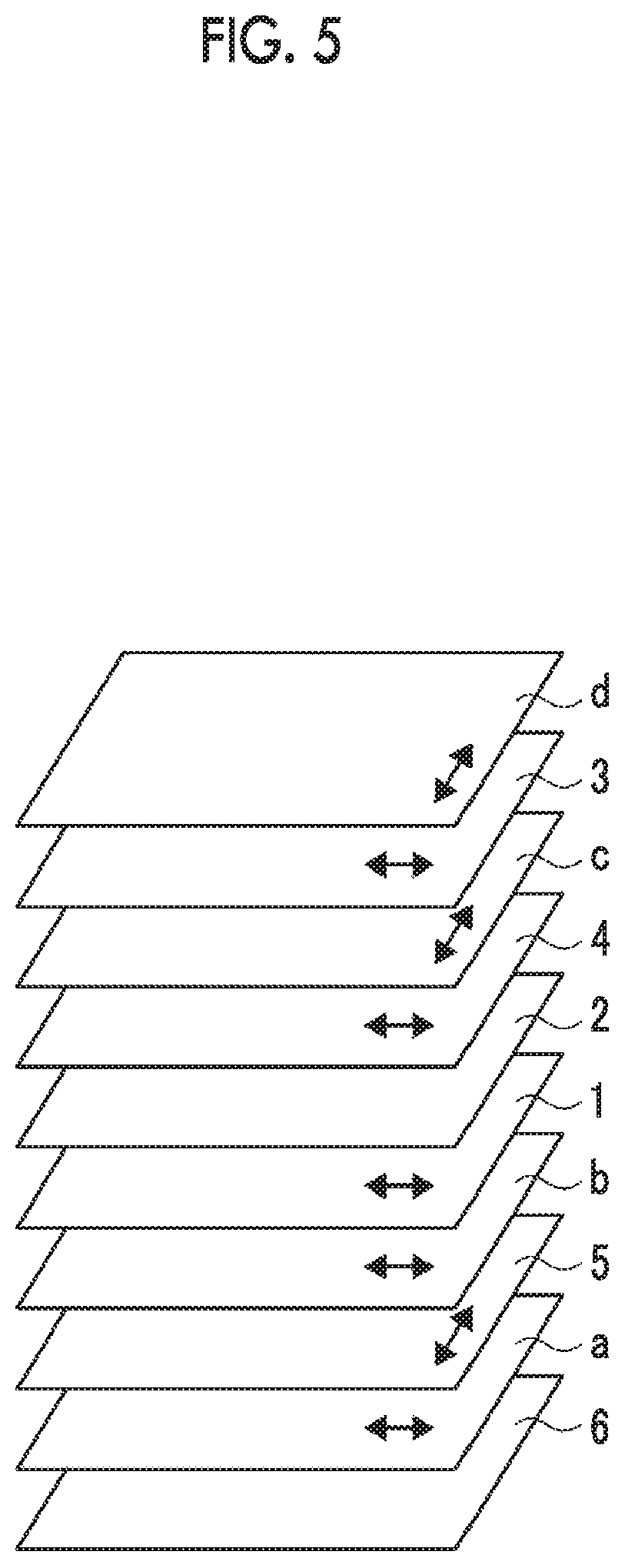Optical film, polarizing plate, image display device, method for producing optical film, and method for producing polarizing plate
a technology of polarizing plate and optical film, which is applied in the direction of polarising elements, solid-state devices, synthetic resin layered products, etc., can solve the problems of cycloolefin-based polymers not being easily closely attached deterioration of adhesiveness to liquid crystal layers, etc., and achieves the effect of ensuring adhesiveness and without deterioration
- Summary
- Abstract
- Description
- Claims
- Application Information
AI Technical Summary
Benefits of technology
Problems solved by technology
Method used
Image
Examples
example 1
[0320]
[0321]One surface of a cycloolefin polymer film (trade name: ARTON FILM, Re=95 nm, Rth=100 nm, film thickness 20 μm, manufactured by JSR Corporation) was subjected to a corona treatment in a discharge amount of 125 W·min / m2 and a liquid crystal layer forming composition 1 prepared with the following composition was applied to the corona-treated surface using a #3.0 wire bar.
[0322]Next, the solvent of the composition was dried and heated with hot air at 70° C. for 90 seconds to mature the alignment of the liquid crystal compound.
[0323]Next, irradiation with ultraviolet rays (300 mJ / cm2) was performed at 40° C. in an oxygen concentration of 0.1% under nitrogen purge and the alignment of the liquid crystal compound was fixed. Thus, an optical film of Example 1 was prepared.
[0324]
Liquid Crystal Layer Forming Composition 1Liquid crystal compound R1 below100.0parts by massAlignment assistant (A1) below1.0part by massCompound B1 represented by Formula (I) below1.0part by massPolymeri...
examples 2 to 17
, Comparative Examples 1 to 4, and Comparative Examples 6 to 9
[0354]Optical films of Examples 2 to 17 and Comparative Examples 1 to 4 and 6 to 9 were prepared and evaluated in the same manner as in Example 1 except that the kind of the polymer film, the film thickness, Re(550), Rth(550), the kind of the liquid crystal compound, the kind and the added amount of the compound represented by Formula (I) above, and the thickness of the liquid crystal layer were changed to values shown in Table 1 above. The results are shown in Table 1 above.
[0355]In Table 1 above, in Examples 16 and 17, a discotic liquid crystal compound was used. Since the phase difference was different from the phase differences in other examples, the alignment was evaluated based on the value of Re(550) with respect to a film thickness of 1 μm of the liquid crystal layer instead of the value of |Rth(550)| with respect to a film thickness of 1 μm of the liquid crystal layer. The evaluation was performed based on the sa...
example 18
[0369]An optical film of Example 18 was prepared in the same manner as in Example 1 except that in the liquid crystal composition, instead of using 250.0 parts by mass of methyl acetate, 250.0 parts by mass of acetone was used, and the thickness of the polymer film, Re(550), Rth(550), the kind of the liquid crystal compound, the kind and the added amount of the compound represented by Formula (I) above, and the thickness of the liquid crystal layer were changed to values shown in Table 1 above. The results are shown in Table 1 above.
PUM
| Property | Measurement | Unit |
|---|---|---|
| thickness direction retardation Rth1 | aaaaa | aaaaa |
| thickness direction retardation Rth2 | aaaaa | aaaaa |
| thickness direction retardation Rth3 | aaaaa | aaaaa |
Abstract
Description
Claims
Application Information
 Login to View More
Login to View More - R&D
- Intellectual Property
- Life Sciences
- Materials
- Tech Scout
- Unparalleled Data Quality
- Higher Quality Content
- 60% Fewer Hallucinations
Browse by: Latest US Patents, China's latest patents, Technical Efficacy Thesaurus, Application Domain, Technology Topic, Popular Technical Reports.
© 2025 PatSnap. All rights reserved.Legal|Privacy policy|Modern Slavery Act Transparency Statement|Sitemap|About US| Contact US: help@patsnap.com



